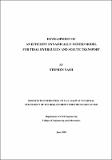| dc.contributor.advisor | Hartnett, Michael | en |
| dc.contributor.author | Nash, Stephen | en |
| dc.date.accessioned | 2010-12-10T10:44:31Z | en |
| dc.date.available | 2010-12-10T10:44:31Z | en |
| dc.date.issued | 2010-06 | en |
| dc.identifier.uri | http://hdl.handle.net/10379/1498 | en |
| dc.description.abstract | Numerical modelling of coastal zones typically requires a high spatial resolution to accurately simulate land-sea interactions, particularly in areas of complex coastlines. As a result, the computational cost of coastal models can become quite prohibitive. Nested models are a possible solution to the spatial resolution problem, allowing the specification of high spatial resolution in areas of interest only. A one-way, multiple nested, adaptive mesh model was developed which simulates both tidal hydraulics and solute transport in the coastal zone.
The child grid boundary operator and the conservation of mass and momentum at the child grid boundary were identified as the most important elements of a nested model; much of the research therefore focussed on these aspects of model design. The boundary operator consists of an innovative adaptive linear interpolation scheme and a Dirichlet boundary condition. A novel approach to child grid boundary formulation was devised. The approach uses ghost cells to enable the formulation of child grid open boundaries as internal dynamic boundaries; this approach ensures high levels of conservation at the child grid boundaries. The approach also offers a novel solution to the moving boundary problem, thus facilitating the flooding and drying of child grid boundaries. To help assess model accuracy a unique mathematical approach to error quantification, the tidally-averaged relative error field, was formulated. This error field enabled simultaneous analysis of the spatial and temporal errors in a model solution and led to the development of an effective procedure for the identification of optimum child grid boundary locations.
The nested model was extensively tested for both idealised and real coastal systems. The results showed that, when applied in the correct manner, the nested model can provide accurate high resolution solutions in particular areas of interest for a much lower computational effort than standard single grid models. | en |
| dc.rights | Attribution-NonCommercial-NoDerivs 3.0 Ireland | |
| dc.rights.uri | https://creativecommons.org/licenses/by-nc-nd/3.0/ie/ | |
| dc.subject | Coastal modelling | en |
| dc.subject | Nesting | en |
| dc.subject | Adaptive mesh | en |
| dc.subject | Hydrodynamics | en |
| dc.subject | College of Engineering and Informatics | en |
| dc.title | Development of an efficient dynamically nested model for tidal hydraulics and solute transport | en |
| dc.type | Thesis | en |
| dc.local.note | A nested numerical model has been developed for the simulation of current flows and solute transport in coastal waters. The model allows the specification of high spatial resolution in areas of interest with lower resolution elsewhere; in this way the computational effort is optimised. | en |
| nui.item.downloads | 545 | |


